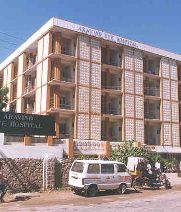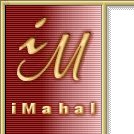|
|
  iMahal Interview Series:
iMahal Interview Series:
G. Venkataswamy
June 17, 2001
 iMahal:
People are calling Aravind "the McDonalds of eye surgery" due to its ability to mass-
produce a quality service at very low cost to customers. Do you like this analogy?
iMahal:
People are calling Aravind "the McDonalds of eye surgery" due to its ability to mass-
produce a quality service at very low cost to customers. Do you like this analogy?

|
|
Blue Arches of Aravind
|
 Venkataswamy:
I do like this analogy. I was 55 when I first saw the golden arches of McDonald's. In
America, there are powerful marketing devices to sell products like hamburgers. All I
wanted to sell was good eyesight, and there are millions of people who need it. If
McDonald's can sell billions of low-cost burgers, it seemed possible to me that we could
sell millions of low-cost sight-restoring operations. So we grew Aravind around the ideas
of efficiency, accessibility, and affordability.
Venkataswamy:
I do like this analogy. I was 55 when I first saw the golden arches of McDonald's. In
America, there are powerful marketing devices to sell products like hamburgers. All I
wanted to sell was good eyesight, and there are millions of people who need it. If
McDonald's can sell billions of low-cost burgers, it seemed possible to me that we could
sell millions of low-cost sight-restoring operations. So we grew Aravind around the ideas
of efficiency, accessibility, and affordability.

iMahal:
In the Aravind Hospitals, the poor patients (70%) are subsidised by the patients who can
pay (30%). However, a few years ago an MBA administrator of Aravind Eye Hospital
proposed a simple method for patients to pay for the cost of materials from successfully
treated cataract operations. After patients were treated and able to rejoin the workforce,
they would pay one month's salary to the hospital. In a preliminary study of the proposal,
patients were found to be cooperative and willing to pay. How did this scheme work?

 Venkataswamy:
At Aravind free section, in the 1980s, the patients received cataract surgery and
medicines free of cost. The surgery then was without an intraocular lens (IOL) implant.
In the 1990s, with local production of IOLs by Aurolab, the cost of the IOL came down
dramatically and so that most of the cataract surgeries, even in the free section, were
done with the implant. The additional cost of providing the cataract surgery with an IOL
implant was determined to be Rs.500. This is less than a fortnight's wages even for the
lowest paid person. Since the patients understood the merits of an IOL implant in a
cataract surgery they were willing to pay the amount. And they could return to work quite
soon after surgery, thus recovering quickly the amount they had to pay for the surgery.
Today almost all the patients that walk into the hospital for free care are paying this
amount. The system of giving credit was never really implemented.
Venkataswamy:
At Aravind free section, in the 1980s, the patients received cataract surgery and
medicines free of cost. The surgery then was without an intraocular lens (IOL) implant.
In the 1990s, with local production of IOLs by Aurolab, the cost of the IOL came down
dramatically and so that most of the cataract surgeries, even in the free section, were
done with the implant. The additional cost of providing the cataract surgery with an IOL
implant was determined to be Rs.500. This is less than a fortnight's wages even for the
lowest paid person. Since the patients understood the merits of an IOL implant in a
cataract surgery they were willing to pay the amount. And they could return to work quite
soon after surgery, thus recovering quickly the amount they had to pay for the surgery.
Today almost all the patients that walk into the hospital for free care are paying this
amount. The system of giving credit was never really implemented.

iMahal:
Your hospitals, via the Aurolab company you helped to start, began to manufacture the
IOL to get them cheaper. But the truth is that now your IOLs are sought after because
they are the best. Will you pursue other manufacturing possibilities, and will they be used
as ways to fund the hospitals?
 Venkataswamy:
To make high-quality eye care affordable, we established Aurolab. It began with
manufacturing intraocular lenses and went on to expand its facilities to manufacture
suture needles and pharmaceuticals. However, the goal remains the same: to develop
appropriate technology to provide instrumentation, equipment, and supplies for eye care
providers at costs affordable by developing economies.
Venkataswamy:
To make high-quality eye care affordable, we established Aurolab. It began with
manufacturing intraocular lenses and went on to expand its facilities to manufacture
suture needles and pharmaceuticals. However, the goal remains the same: to develop
appropriate technology to provide instrumentation, equipment, and supplies for eye care
providers at costs affordable by developing economies.


 

|
 |



